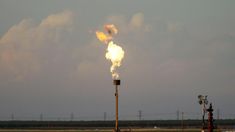Business
In 10 months, $341 million in gas flaring fines were levied by NOSDRA

According to the National Oil Spill Detection and Response Agency (NOSDRA), from January to October of this year, the fine for flaring gas in Nigeria was $341.1 million.
The Nigeria Gas Flare Tracker (GFT), a satellite-based tool developed by NOSDRA, was used to gather the data for this investigation.
When pumped up from the ground, gas flares are the surface combustion or burning of natural gas that is frequently related to the extraction of crude oil.
The statutory fine for gas flaring in Nigeria at the moment is $2 per 1,000 standard cubic feet, according to NOSDRA (scf).
For every 1,000 scf of gas flared currently, businesses that produce more than 10,000 barrels per day (bpd) pay a fine of $2, while those that produce less than 10,000 bpd pay a fine of $0.5.
The fine for gas flaring was raised by the federal government in 2018 from $10 per 1,000 standard cubic feet (scf) to $2 for 1000 scf of gas released.
Furthermore, Nigeria has had several regulatory restrictions against gas flaring in effect since 1969. Flaring gas in Nigeria has been prohibited since 1984 unless authorized in writing by the minister of petroleum resources.
According to GFT, the flared gas released 9.1 million metric tons of carbon dioxide into the atmosphere between January and October 2022, costing $596.9 million.
Additionally, the gas flared has a 17.1 gigawatt/hour capacity for power production.
Because these gases can be exported or utilised locally by power companies and other wholesale energy customers, gas flaring also results in economic losses.
According to Okoka Darlington, an electrical design consultant, “businesses pay less for gas flaring by the Ministry of Environment than they will use to capture the gas.”
“Oil-producing businesses will find a means to convert the gas to electricity if the penalty for flaring gas is higher.”
According to Darlington, businesses that flare gas should be forced to pay a high price to clean up their act.
According to the World Bank, regulations that impose penalties on companies that flare gas may not always be effective at curtailing the practice, especially if flaring and paying a penalty is more economically viable than capturing the gas and selling it.
It said, “Oil operators can re-inject associated gas back into the ground or build the infrastructure needed to capture, store and transport the associated gas to market.”
“Meanwhile, governments can implement effective regulations and policies to incentivize and encourage gas flare reduction.”
According to NOSDRA, flared gas could be harnessed to provide electricity, which Nigeria faces an acute shortage of.
“This could be done at a local scale, or by feeding into Nigeria’s national grid,” it said.
“However, this is in poor repair, and to promote gas-to-power programs that can assist in addressing Nigeria’s power difficulties, a mix of infrastructure, legislation, and investment is required.”
The major issue, according to Chinedu Onyegbula, a director at Bullox Resources Limited and an expert in the energy sector, is that foreign oil corporations (IOCs) have been able to get away with flaring and not paying the necessary penalties.
According to Onyegbula, “One cause could be the regulatory agency’s complicity through compromise, Nigeria’s incapacity to validate gas flaring data from IOCs and the fact that not much has been done to punish the IOCs for their activities.”
According to Onyegbula, Nigeria should enforce current laws and give the regulator the tools and authority necessary to carry out its duties.
He added that stricter legislation should be passed to make gas flaring illegal and punishable, as well as to provide incentives for parties throughout the value chain to commercialize gas burning, particularly those who purchase it from places where it is flared.
It is said that efforts to halt flaring are being hampered by Nigeria’s failure to launch the gas flare commercialization program that the government approved in 2016.
An ambitious strategy to sell more than 700 million scf of gas per day flared at 178 distinct locations is the Nigerian Gas Flare Commercialization Programme. Under the new regulatory body established by the Petroleum Industry Act, the program is scheduled to resume.
